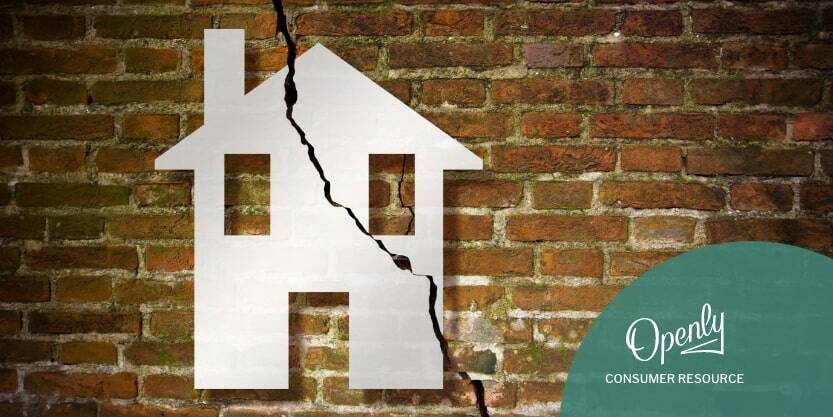The foundation of your home is suddenly showing signs of distress. Cracks snake across the basement floor and doors are sticking. This begs the question: does home insurance cover foundation repair?
This guide will crack the code on homeowners insurance foundation coverage and help you navigate this often confusing coverage.
At a glance:
- Homeowners insurance may cover foundation damage, but it depends on the cause. Coverage typically extends to sudden, direct physical loss but typically not wear, tear, and / or deterioration.
- Early detection of foundation problems is critical. Watch for signs like cracks in walls, uneven floors, and difficulty with doors and windows.
- Understanding your homeowners insurance policy is essential. Review the policy carefully to know what's covered and what's not. Consider consulting with an insurance agent for clarification.
Understanding foundation insurance coverage
The foundation is the bedrock of your home. It can be a basement, crawlspace, or slab, each with its own characteristics.
Basements can provide additional living, storage, and / or utility space below ground level. Crawlspaces can act as a barrier between the ground and the home’s floor. They offer a confined space beneath the home and are often used for utilities. Slab foundations are concrete pads poured directly on compacted soil.
Regardless of type, a strong foundation is vital for maintaining the structural integrity of your home. So how does home insurance protect against foundation nightmares?
Common causes of foundation problems
Several factors can contribute to foundation problems. Soil saturation from improper drainage or leaking pipes can cause the soil to expand and put stress on the foundation. Natural wear and tear over time can also lead to cracks and settling. Additionally, external forces like tree roots growing too close to the foundation or pressure from expansive soils can cause structural damage.
Coverage scope for foundation issues
Does homeowners insurance cover foundation issues? The answer depends on the cause of the damage.
Home insurance typically covers foundation damage caused by covered perils (as outlined in your homeowners insurance policy). These are typically sudden and accidental events such as:
- Severe weather, e.g. tornadoes, strong winds, hailstorms, or lightning strikes
- Foundation damage from a vehicle impact to the house1
- Sudden water damage, like a burst pipe
Keep in mind that there are some exclusions that homeowners insurance typically does not cover, including foundation damage caused by earthquakes, floods, or poor maintenance (such as improper drainage or failure to address existing cracks.)
Understanding the nuances of exclusions
Understanding exclusions is just as important as knowing what's covered. Here's a closer look at some common reasons why foundation repairs might be excluded from your homeowners insurance2:
- Foundation settling—Foundations naturally settle over time. This gradual movement is considered wear and tear and typically isn’t covered by insurance.
- Faulty construction—If foundation problems stem from issues present during construction3, homeowners insurance will likely not cover repairs. (This highlights the importance of thorough home inspections before purchasing a property.)
- Deterioration due to age—Foundations naturally deteriorate with age. Cracks or foundation leaks caused by normal aging typically aren't covered by insurance.

Recognizing signs of foundation damage
Being aware of the signs of foundation damage is crucial for early intervention. Early detection can save you significant money on repairs down the road. Here are some telltale indicators of foundation damage:
Cracks in walls
Horizontal or diagonal cracks in walls, especially near doorways or windows, can signal foundation issues. Pay special attention to the size and direction of the cracks; wider cracks or those that appear jagged or stair-stepped might indicate more serious problems.
Uneven floors
Floors that slope or become uneven could signify foundation movement. This can be caused by settlement, which is the natural sinking of the foundation over time. Uneven floors can also be caused by problems with the subgrade, the layer of soil directly below the foundation. To test for uneven floors, place a marble on the floor and observe its movement.
Difficulty with doors and windows
Doors and windows that stick, become misaligned or are hard to open or close may indicate foundation issues. These types of problems can also be caused by warping due to temperature fluctuations, so it is important to regularly check your windows and doors or seek professional evaluation.
Water leaks
Moisture accumulation around the foundation can lead to leaks and potential foundation problems. Water leaks can be caused by cracks in the foundation, faulty drainage, or a high water table. Leaking water weakens the foundation and can cause mold growth (which may or may not be covered by your specific home insurance policy).
If you live in a particularly wet climate, consider a home insurance policy with accompanying endorsements that may cover water seepage or water backup, like Openly, to ensure that you have comprehensive protection.
Drainage issues
Standing water pooling near the foundation can put pressure on it and cause cracks. Poor drainage can be caused by improper grading around the house, clogged gutters, or downspouts that drain too close to the foundation.
Filing a claim for foundation repair
The claims process can vary depending on your insurance company and the severity of the damage. If you suspect foundation damage covered by your policy, here's what you can expect from the process:
- Contact your insurance provider promptly.
- Take photos and videos of the cracks, uneven floors, water leaks, or any other signs of foundation damage. Include close-up photos of cracks, wide shots showing the overall affected area, and timestamps on your photos. If possible, include photos from before the damage occurred to provide a baseline for comparison.
- Your insurance company may send an adjuster to assess the damage and determine coverage. Be prepared to answer questions about the timeline of the damage, recent events that might have caused it, and any previous repairs done to the foundation.
- Once the insurance company determines coverage, obtain estimates from qualified foundation repair contractors.

Preventing foundation damage
Proactive measures can go a long way in preventing costly foundation repairs. Here are 5 tips for keeping your foundation strong and stable:
1. Maintain proper water drainage
Ensure proper grading around your house to divert water away from the foundation. A slope of at least 3% away from the foundation in the first ten feet is recommended.4
You should also regularly clean gutters and downspouts to avoid water pooling near the foundation. Consider installing extensions on downspouts to direct water further away from the house.
2. Monitor tree root growth
Keep trees with aggressive root systems at a safe distance from your home's foundation. Consult with a landscape professional to determine appropriate planting distances for trees. In some cases, root barriers may be necessary to prevent roots from encroaching on the foundation.5
3. Address foundation cracks promptly
Don't ignore small cracks. Get them inspected and repaired by a professional foundation specialist to prevent further damage. Small cracks can be sealed relatively inexpensively, while larger cracks or those that continue to grow may require more extensive and costly repairs.
4. Conduct regular foundation inspections
Schedule professional inspections of your foundation every few years, especially in areas prone to foundation problems due to soil conditions. Early detection of issues can save you money in the long run.
5. Maintain a healthy crawlspace
For homes with crawl spaces, ensure proper ventilation to prevent moisture buildup. Consider installing a vapor barrier to further reduce moisture levels.6 Regularly inspect the crawlspace for leaks, signs of insect infestation, or mold growth.

Don’t let foundation issues surprise you
Understanding home insurance foundation coverage and repair empowers homeowners to make informed decisions. While homeowners insurance often covers foundation damage caused by sudden and accidental events, exclusions apply. Familiarizing yourself with your policy's coverage details and taking proactive measures to prevent foundation problems can significantly reduce the risk of costly repairs.
Openly is here to help you navigate the complexities of homeowners insurance. Our experienced agency partners can answer your questions, explain your policy coverage, and help you find the right insurance plan for your needs. Connect with an independent agent today to obtain a quote for Openly home insurance and peace of mind knowing your home, from its foundation to its roof, is well-protected.
*We provide this information to help you understand insurance. Any coverage is subject to the terms of your policy. Please refer to your policy and declarations page for complete terms, conditions and coverage details.
1 Mandy Sleight.“Does Homeowners Insurance Cover House Foundation Repair?” US News & World Report. Published 21 May 2024. Accessed 23 July 2024. https://www.usnews.com/homeowners-insurance/does-home-insurance-cover-house-foundation-repair
2 Shannon Martin. “Does homeowners insurance cover foundation repair?” Bankrate. Published 3 June 2024. Accessed 23 July 2024. https://www.bankrate.com/insurance/homeowners-insurance/does-homeowners-insurance-cover-foundation-repair/
3 For CT residents, see CT Department of Housing for more information and resources about crumbling foundation issues https://portal.ct.gov/doh/doh/programs/crumbling-foundations
4 Allentuck Landscaping. “Grading for Drainage: How to Improve Your Home’s Drainage.” Published 7 October 2023. Accessed 24 July 2024. https://www.allentucklandscaping.com/grading-for-yard-drainage/
5 Done Right Foundation Repair. “How Trees and Their Roots Can Affect Your Foundation.” Updated 8 November 2022. Accessed 24 July 2024. https://donerightfoundationrepair.com/how-trees-can-affect-your-foundation/
6 Brad Hull. “Everything You’ve Ever Wanted to Know About Crawl Space Vapor Barriers.” W.R. Meadows. Published 17 January 2023. Accessed 24 July 2024. https://www.wrmeadows.com/blog/crawl-space-vapor-barrier/




